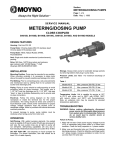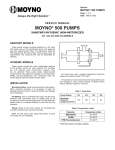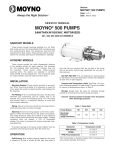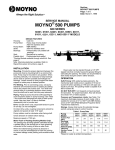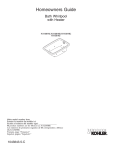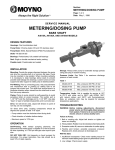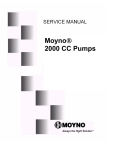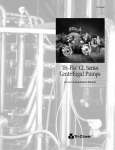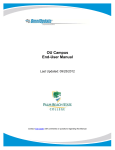Download Moyno® Metering/Dosing Pump :: Service Manual (Closed
Transcript
Section: METERING/DOSING PUMPS Page: 1 of 4 Date: May 1, 1998 SERVICE MANUAL METERING/DOSING PUMP CLOSE-COUPLED B4015B, B4100B, B4190B, B4190C, B4015D, B4100D, AND B4190D MODELS DESIGN FEATURES Housing: Cast iron/316 SS Pump Rotor: Chrome plated AISI 416 stainless steel/ Chrome plated 316 stainless steel Pump Stator: Nitrile, Natural Rubber, EPDM, Fluoroelastomer Seal: Single and double mechanical (carbon/ceramic), packing Drive: 56C-face, 140TC-face motors and reducers, gear reducers with 120 MM flange, 1" shaft (Example SEW EURODRIVE R40F) INSTALLATION Mounting Position. Pump may be mounted in any position. When mounting vertically, it is necessary to keep motor above the seals to prevent possible seal leakage into motor. Pre-Wetting. Prior to connecting pump, wet pump elements and mechanical seal by adding fluid to be pumped into suction and discharge ports. Piping. Piping to pump should be self-supporting to avoid excessive strain on pump housings. The suction port is 1-1/2" NPT and the discharge port is 1-1/4" NPT. Use pipe “dope” or tape to facilitate disassembly and to provide seal on pipe connections. Electrical. Follow the wiring diagram on the motor nameplate or inside the terminal box for the proper connections. The wiring should be direct and conform to local electrical codes. Check power connections for proper voltage. Voltage variations must not exceed ±10% of nameplate voltage. Motor is provided with internal automatic overload protection. To prevent damage to pump, pump rotation must be clockwise when facing pump from motor end. OPERATION Self-Priming. With wetted pumping elements, the packed pump is capable of 25 feet of suction lift with pipe size equal to port size. Be sure suction lines are air tight or pump will not self-prime. Self-priming capabilities will vary due to fluid viscosity. Mechanical seal pump can suction lift to 15 feet. DO NOT RUN DRY. Unit depends on liquid pumped for lubrication. For proper lubrication, flow rate should be at least 10% of rated capacity. Storage. Always drain pump for extended storage periods by removing bottom drain plug in pump body. Pressure Limits. See Table 1 for maximum discharge of each model. Table 1 Models 4015 Max. pressure 300 PSI, 20 bar Models 4100 Max. pressure 300 PSI, 20 bar Models 4190 Max. pressure 175 PSI, 12 bar Temperature Limits. Unit is capable for service at 10°F to 210°F with nitrile, and to 260°F with EPDM, 185°F with natural rubber, and 350°F with fluoroelastomer. Note, an undersize rotor may be required for elevated temperature applications. TROUBLESHOOTING WARNING: Before making adjustments, disconnect power source and thoroughly bleed pressure from system prior to disassembly. Failure to do so could lead to electric shock or serious bodily harm. Failure to Pump. 1. Motor will not start: Check power supply. Voltage must be ±10% of nameplate rating when motor is in locked rotor condition. Check for faulty capacitor on 1 phase models. 2. Motor runs and thermally kicks out: Check for excessive discharge pressure. Check for defective centrifugal switch on 1 phase models. Increase ventilation to motor. Do not use less than #14 wire size. Page 2 3. Stator torn; possible excessive pressure: Replace stator, check pressure at discharge port. 4. Flexible joint broken; possible excessive pressure: Replace joint, check pressure at discharge port. 5. Wrong rotation (3 phase only): Rotation must be clockwise when facing pump from motor end. Reverse the connections of any two line leads to the motor. Pump Overloads. 9. Clean and inspect the flexible joint (24) looking for excessive play and breaks in the rubber boots. If sealing boots are damaged replace the flexible joint. 10. If packed model skip to Step 14. Single Seal. Remove the mechanical seal (69) spring and spring retainer from the drive shaft assembly (26). Double Seal. Remove seal housing (71) and O-ring (72), inspect, replace if necessary. 1. Excessive discharge pressure. Check pressure at discharge port for maximum ratings given in Table 1. 11. Remove the rotational portion of the mechanical seal from the drive shaft (26). 2. Fluid viscosity too high: Limit fluid viscosity per “How to Select” calculations. 12. Remove the seal housing (3) or seal gland (73) from the drive adapter casting (1). Noisy Operation. 13. Remove the mechanical seal stationary from the seal housing (3) (71) and seal gland (73). Replace seal components if worn. Go to Step 16. 1. Excessive suction lift or vacuum: Maximum suction lift is 25 feet for water. 2. Suction line too small: Check pipe size. Be sure lines are free from obstructions. 3. Pump Cavitates: At pump speed of 1725 rpm. Viscosity of fluid should not exceed 100 CP or 500 SSU. 4. Flexible joint worn: Replace joint. Check pressure at discharge port. 5. Insufficient mounting: Mount to a firm base. Vibration induced noise can be reduced by using mount pads and short sections of hose on suction and discharge ports. Seal Leakage. 1. Leakage at startup: If leakage is slight, allow pump to run several hours to let faces run in. 2. Persistent seal leakage: Faces may be cracked from freezing or thermal shock. Replace seal. Pump Will Not Prime. 1. Air leak on suction side: Check pipe connections. PUMP DISASSEMBLY WARNING: Before disassembling pump, disconnect power source and thoroughly bleed pressure from system. Failure to do so could result in electric shock or serious bodily harm. 1. Remove suction and discharge piping. Drain pump body by removing drain plug (261). 2. Remove discharge coupling (9) from stator (21). 3. Remove stator support clamp (40). 4. Remove stator (21) by unthreading from the suction housing (2). Lock rotor from turning by inserting a punch into the hole located in the center of the flexible joint (24). This will aid in removing the stator. 5. Remove the stator support retainer (39) if desired. 14. Remove the stuffing box (4) from the drive adapter casting (1). 15. Remove the packing gland halves (65) from the studs and remove the worn packing (72). 16. Remove the set screws (27) from the drive shaft assembly (26). 17. Remove the drive shaft assembly (26) from the motor/gearmotor shaft. 18. Remove the drive adapter casting from the motor/ gearmotor. This completes the pump disassembly. PUMP ASSEMBLY 1. Mount the drive adapter casting (1) to the motor/gearmotor, using appropriate hardware with the windows horizontal. 2. Slide the drive shaft assembly (26) onto the motor/ gearmotor shaft, seating firmly against the shaft end. 3. Install the set screws (27) into the drive shaft assembly (26) locking the drive shaft assembly to the motor/gearmotor shaft. 4. On packed pump skip to Step 5. Install the mechanical seal (69) (70) using the following procedure: a. Clean and oil sealing faces using clean oil (not grease). CAUTION: Do not use oil on EPDM parts. Substitute glycerin or soap and water. b. Oil outer surfaces of the seal seat, and push seat assembly into the seal housing (3) and seal gland on double seals. c. Slide the seal housing (3) or seal gland (73) onto the drive shaft assembly (26) seating into the drive adapter (1). 6. Remove the suction housing (2) by removing the screws (112) and lock washers (215). d. After cleaning and oiling the shaft, slide the seal body along the drive shaft assembly (26) until it meets the seal seat. 7. Remove O-Ring (270) from the seal housing (3) (71) or the stuffing box (4). Inspect and replace if necessary. e. Install the seal spring and spring retainer or second seal body on the shaft. 8. Remove the rotor & shaft pins (46) from the flexible joint (24). Support the joint/rotor while removing with a small punch. These pins should not be reused. Replace with new pins upon reassembly. f. On double seal models, insert seal stationary into seal housing (71), mount O-ring (72) and slide onto shaft, enclosing the double seal. Page 3 11. Slide stator (21) onto rotor (22) using hand soap or equivalent as lubrication. Thread stator into suction housing (2) using pipe “dope” or sealing tape to ensure a leak-proof seal. To keep the rotor from turning, insert a punch into the hole in the flexible joint. 5. On packed pumps perform the following: a. Insert the packing rings (72) into the stuffing box alternating the joints 90˚. b. Install the packing gland halves (65) on the studs (70) without tightening on the packing. 12. Slide stator support retainer ring (39) onto the stator. c. Slide the stuffing box assembly onto the drive shaft assembly (26). Set the studs horizontal, seating the stuffing box into the drive adapter casting. 13. Use the stator support clamp (40) to connect the stator support (38). 14. Thread discharge coupling (9) onto the stator (21) using pipe “dope” or sealing tape to ensure a leak-proof seal. 6. Insert the flexible joint (24) into the drive shaft assembly (26). Insert shaft pin (46) into the hole using a small punch. The seal spring will move to allow clearance for insertion. The spring retainer should rest against the flexible joint (24) after pin insertion. 15. Lubricate rotor and stator by filling the suction housing with fluid to be pumped. 16. Firmly mount the pump. Connect suction and discharge piping and power source. 7. Support flexible joint and insert rotor (22) aligning holes for insertion of rotor pin (46) using a small punch. 8. Insert O-Ring (270) into the groove in the seal housing (3) or stuffing box (4). PARTS LIST To determine part numbers for all parts, enter the table on the following page with the item number from the pump illustration below. Then locate the part number under the applicable model number. Notice the type column identifies the materials of construction. Parts listed with one part number for example are applicable to all models. 9. Install the drain plug (261) into suction housing (2) using pipe “dope” or sealing tape to ensure a leak-proof seal. 10. Attach the suction housing (2) to the drive adapter casting, using screws (112) and lockwashers (215). Note, a gap will remain between the suction housing and drive adapter casting. 73 71 70 Double Seal Models CAUTION: When mounting motor, gearmotor or reducer, use care in coupling the pump shaft to the motor shaft to avoid seal damage. 3 Single Seal Models 3 270 72 69 1 27 26 270 Packing Models 4 261 70 65 215 112 72 21 300 24 2 40 39 22 46 38 Remove two positioning set screws after mounting drive 9 Page 4 CLOSE COUPLED MODELS PARTS LIST PUMP MODELS Item Type 1 CD/SS 2 CD 2 SS 3 CD/SS 4 CD/SS 9 CD 9 SS 21 Q 21 R 21 B 21 F 22 CD 22 SS 24 Q, R 24 B 24 F 26 CD/SS 27 CD/SS 38 CD/SS 39 CD/SS 40 CD/SS 46 CD/SS 65 CD/SS 69 Q, R 69 B 69 F 69 Q, R 69 B 69 F 70 CD/SS 70 Q, R 70 B 70 F 71 CD/SS 72 CD/SS 72 Q, R, B, F 73 CD/SS 112 CD/SS 215 CD/SS 261 CD 261 SS 270 Q, R 270 B 270 F 300 CD/SS Description Drive Adapter Suction Housing Suction Housing Seal Housing Stuffing Box Discharge Coupling Discharge Coupling Stator Stator Stator Stator Rotor Rotor Flexible Joint Flexible Joint Flexible Joint Drive Shaft Assy. Set Screw Stator Support Sta. Sup. Retainer Clamp Assy. Rotor/Shaft Pin Packing Gland Half Mechanical Seal Std. Mechanical Seal Std. Mechanical Seal Std. Mechanical Seal Std. Mechanical Seal Std. Mechanical Seal Std. Stud Double Mech. Seal Double Mech. Seal Double Mech. Seal Seal Housing, Double Packing Set O-Ring Seal Gland, Double Screw Lock Washer Drain Plug Drain Plug O-Ring O-Ring O-Ring Name Plate Req. 1 1 1 1 1 1 1 1 1 1 1 1 1 1 1 1 1 2 1 1 1 2 2 1 1 1 1 1 1 2 1 1 1 1 1 1 1 4 4 1 1 1 1 1 1 B4015B B4100B B4190B B4190C B4015D 350168801 3403923104 3403923204 3403923304 3403923504 3403927007 3403927015 3403924104 3403924204 3403924309 3403924504 3403928007 3403928015 3403943001 3403932001 3403932007 3403930007 3403934007 3205341020 3205342020 3403925104 3403925104 3403923104 3403925204 3403925204 3403923204 3403925304 3403925304 3403923304 3403925504 3403925504 3403923504 3403929007 3403929007 3403927007 3403929015 3403929015 3403927015 3308811001 3308811003 3308811005 3403943002 6060340040 3403945001 3201733000 3204277000 and 3201734000 3204069001 3403933007 3202424000 3206379000 3206501000 3206460000 3206502000 3206503000 3208591000 3208652000 3208652001 3208652002 3403986015 3403396002 3207902128 3403985015 6191520141 6230010401 6100120031 6100420030 3207902134 3207904134 3207905134 3208597000 B4100D B4190D 3501688003 3403924104 3403924204 3403924304 3403924504 3403928007 3403928015 3403925104 3403925204 3403925304 3240392504 3403929007 3403929015 3403943003 Note: For further information, call 800-845-1310 (Western USA) 800-325-1331 (Central & Eastern USA), or 937-327-3553 (Ohio) © 1998 by Moyno, Inc. ® Moyno is a registered trademark of Moyno, Inc. Moyno, Inc. is a Unit of Robbins & Myers, Inc. 320-8595-000 Printed in U.S.A. Double The Length Of Your Moyno Pump Warranty For FREE! For your free pump warranty extension, choose from one of the three options below: 1. Go to www.moyno.com and fill out the registration form online 2. Mail this form by placing it in an envelope and sending it to: Moyno, Inc. Attn: Tish Wilson P. O. Box 960 3. Fax this form to 937-327-3177 Springfield, OH 45501-0960 U.S.A. Thank you for choosing a Moyno Pump. Please take the time to complete this warranty registration form.Upon receipt of your form, your standard limited warranty on defective material and workmanship will be extended to twice the standard period of time at no additional cost to you. We appreciate your business and look forward to serving you in the future. MOYNO ™ Always Insist on Genuine Moyno Replacement Parts! Moyno® Pump Warranty Registration Pump Model # Pump Serial # Purchased From Date Purchased Your Name Your Title Your Company Name Address City/State (Province)/Zip Code Phone Number Fax Number E-mail Application for Which This Pump Was Purchased Material Flow Rate Process Temperature Operating Speed Viscosity pH Value Hours Operated per Day Continuous Intermittent Discharge Pressure Suction Pressure NPSH Available Percent of Solids Particle Size Abrasion Rating How Did You First Hear of Moyno Pumps? ❑ Advertisement ❑ Distributor Salesperson Thank You! ❑ Postcard ❑ Trade Show ❑ Previous Experience With Moyno Pumps ❑ Referral ❑ Other – Explain Below





